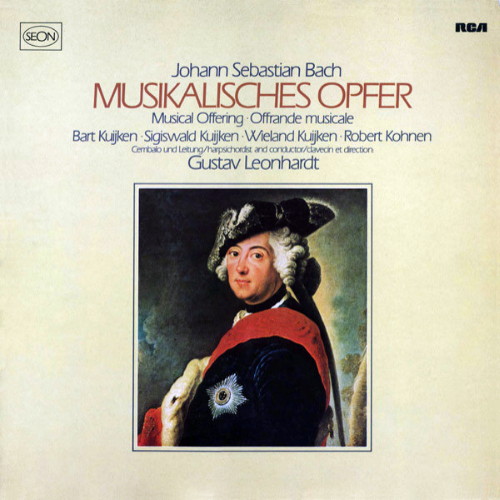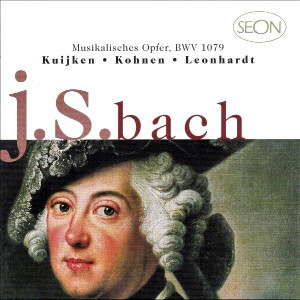 |
1 LP -
6575 042 - (p) 1974
|
 |
| 1 LP -
RL 30420 - (p) 1981 |
 |
| 1 CD -
SBK 63189 - (c) 1997 |
|
MUSIKALISCHES
OPFER
|
|
|
|
|
|
|
|
| Johann Sebastian
BACH (1985-1750) |
Musikalisches
Opfer, BWV 1079 |
|
|
|
|
|
Ricercar
a 3 voci (Harpsichord) |
|
5' 52" |
A1
|
|
|
Canon perpetuus super thema
regium (Flute, Violin, Continuo) |
|
1' 01" |
A2
|
|
|
Canones
diversi |
|
6' 49" |
A3 |
|
|
a)
Canon a 2 (Harpsichord) |
1' 10" |
|
|
|
|
b)
Canon a 2 (Two Violins, Continuo) |
0' 48" |
|
|
|
|
c)
Canon a 2, per motum contrarium (Flute,
Harpsichord) |
0' 50" |
|
|
|
|
d)
Canon a 2, per augmentationem, contrario
motu (Two Violins, Bass Viol) |
1' 18" |
|
|
|
|
e)
Canon a 2, per tonos (Violin, Harpsichord) |
2' 53" |
|
|
|
|
Fuga
canonica in epidiapiente (Violin,
Harpsichord) |
|
2' 03" |
A4 |
|
|
Ricercar
a 6 (Harpsichord) |
|
9' 14" |
A5 |
|
|
Canon
a 2, Quaerendo invenietis
(Harpsichord) |
|
1' 10" |
B1 |
|
|
Canon
a 4, (Two Harpsichords) |
|
1' 55" |
B2 |
|
|
Sonata
a flauto traverso, violino e basso
continuo (Flute, Violin, Basso
Continuo)
|
|
16' 49" |
B3 |
|
|
-
Largo |
4' 15" |
|
|
|
|
-
Allegro |
5' 41" |
|
|
|
|
-
Andante |
3' 43" |
|
|
|
|
-
Allegro |
2' 52" |
|
|
|
|
Canon
perpetuus, contrario motu (Flute,
Violin, Continuo)
|
|
2' 04" |
B4 |
|
|
|
|
|
|
| Barthold Kuijken,
Transverse flute (Gerard A. Rottenburgh,
Bruxelles, mid- 18th century) |
|
| Sigiswald Kuijken,
Baroque Violin I (Maggini School,
Brescia, mid- 17th century) |
|
| Marie Leonhardt,
Baroque Violin II (Jacobus Stainer,
Absam, 1676) |
|
| Wieland Kuijken,
Bass Viol (Tyrol, 18th century) |
|
| Robert Kohnen,
Harpsichord Nr. A2, A3b, B2, B3, B4
(David Rubio, Oxford, 1973) |
|
| Gustav Leonhardt,
Harpsichord solo and Musical Director
(Johannes D. Dulcken, Antwerp, 1755) |
|
|
|
|
|
Luogo
e data di registrazione |
|
Doopsgezinde Kerk,
Amsterdam (Holland) - Marzo 1974
|
|
|
Registrazione: live
/ studio |
|
studio |
|
|
Producer /
Recording Supervisor |
|
Wolf Erichson
|
|
|
Recording Engineer
|
|
Dieter Thomsen
|
|
|
Prima Edizione LP |
|
Seon (Philips) | 6575
042 | 1 LP - durata 48' 04" | (p)
1974 | ANA
Seon (RCA Red Seal) | RL 30420 | 1
LPs - durata 48' 04" | (p) 1981 |
ANA
|
|
|
Edizione CD |
|
Sony | SBK 63189 | 1
CD - durata 48' 04" | (c) 1997 |
ADD
|
|
|
Original Cover
|
|
Antoine Pesne (18.
Jh.) - Friedrich der Große als
Kronprinz, Gemälde
|
|
|
Note |
|
-
|
|
|
|
|
Bach's later
years were spent very much
in retirement and were
chiefly devoted to ordering
and completing his musical
life's work. Only a few
pupils and friends were
aware of the significance of
what he had created. He must
have been all the more
delighted with the
invitation from Friedrick
the Great, transmitted to
him through his son Carl
Philip Emmanuel, then in the
king's service, to perform
on the organ in Potsdam. At
this memorable meeting on
May 7, 1747 Bach's
improvisations on a theme
set by the king met with the
utmost approval. On his
return, handsomely rewarded,
to Leipzig he immediately
started to work out a series
of compositions based on
this royal theme. As early
as July 7 he released the
first movements, collected
under the title of the
"Musical Offering," engraved
with much care and bearing a
dedication to King
Friedrick. Further works
followed at intervals until
the collection was complete
in its present form.
The "Musical Offering" is
not only a work of art sui
generis of the highest
quality; it also pays homage
to the king with genuine
Baroque exuberance. Bach's
marginal notes to the fourth
and fifth canons are to be
interpreted as decoratively
allegorical - in the fourth
at the augmentation "Notulis
crescentibus crescat fortuna
Regis" (May the king's
fortunes increase with the
increasing note-values) and
in the fifth "Ascendente
modulatione ascendat gloria
Regis" (May the king's fame
rise as these modulations
rise). The trio-sonata with
its obbligato flute part
also makes a bow in the
direction of the
flute-playing king. However,
it is the royal theme which
refers most closely to the
monarch. It lies at the root
of all the movements of the
"Musical Offering" in
variants of all kinds,
though we can say with
virtual certainty that it is
not in the original form as
set by Frederick the Great,
but edited by Bach's hand
with a view to subsequent
arrangement. However, it is
not difficult to
reconstitute the structural
elements used by the king.
Two conventional models of
fugal subject are involved -
a rising interval of a sixth
with a falling minor seventh
and a chromatic descent
within the compass of a
fifth. They would have been
familiar to every composer
around 1700 as typical
thematic formulas. Bach
altered them carefully and
sharpened them rhythmically
without, however, touching
them in essentials; any
interpolation would have
amounted to rejecting the
king's theme.
The movements of the
"Musical Offering" are
classic examples of the late
style of Bach which was to
lead a few years later to
his last great work - "The
Art of Fugue." It is
characterised by an austere,
extremely strict and
unusually dense polyphony
whose ultimate issue is the
canon and which renoances
euphory and an attractive
melodic line in favour of
the spiritual depths od
counterpoint. A further
characteristic of this style
is that it is no longer
primarily conceived in terms
of a specific instrument and
its technique (apart from
the flute trio-sonata
specially composed for the
king), but that its
realisation in sound is
permissible to any
instrument having the
appropriate range. In no
other of his creative
periods was the Cantor of
St. Thomas's so
uncompromisingly disposed to
retrospection and so
inclined to place the
spiritual depth of a work
above its sensuous aspect as
he was in his late period.
Bach called two of his
poliphonic movements not
fugues but ricercares
knowing full well that this
forerunner of the fugue from
about 1600 would allow him
on the one hand greater
freedom of form and on the
other the utmost possible
contrapuntal concentration.
The version we have of the
introductory ricercare in
three parts may have
developed directly from the
improvisation which occured
in the King's presence.
It is characterized by the
freedom of expression and
unrestraint which are
associated with any
extempore performance. The
great ricercare in six
parts, however, was composed
at Bach's desk in Leipzig.
Bach refused to improvise a
six-part fugue on the royal
theme in front of Frederick
the Great, using a theme of
his own at that meeting with
the excuse that not every
sunject lent itsekf to
treatement in six parts.
Later, however, he worked
out in the silence of his
room the splendid movement
which represents the ne
plus ultra of all his
fugues in terms of
contrapuntal concentration
and artistic skill in order
to prove the serviceability
of the royal theme.
The canons on the royal
theme, 10 in all including
the "Fuga canonica in
epidiapente" (canon at
the fifth), also express the
ultimate compression of
form, in these Bach strove
constantly to wrest fresh
and deeply significant
possible combinations from
the theme, using every
refinement. Moreover the
cast the two canons
preceding the sonata in the
form of "puzzle canons"
(much in favour in the later
Middle Ages), in which any
indication of the entry of
the voices is deliberately
omitted. While the canon in
four voices is
straightforward, that in two
voices, to which Bach added
the note "Quaerendo
invenietis" (Seek and ye
shall find), admits to
various solutions with which
many generations of
musicians deeply versed in
counterpoint have occupied
themselves. The trio-sonata
is no less brilliantly
worked out: the theme is
more or less obviously
present in all its four
movements - used partly as a
strict cantus firmus
in the Allegro,
partly as a mere thematic
reference in the Largo.
Certain overlapping
associations lead one to
deduce that the three-part
ricercare supplied musical
material for the Andante
of the sonata. In this
trio too, the art of
shaping a movement and the
logic of the development
approach the very limit of
musical possibilities. The
collected "Musical
Offering" represents
the absolute apex of "ara
combinatoria" and "Ars
inveniendi" - that is of
that spiritualizing process
of music to which the West
owes so much.
Lothar
Hoffmann-Erbrecht
|
  |
|
|